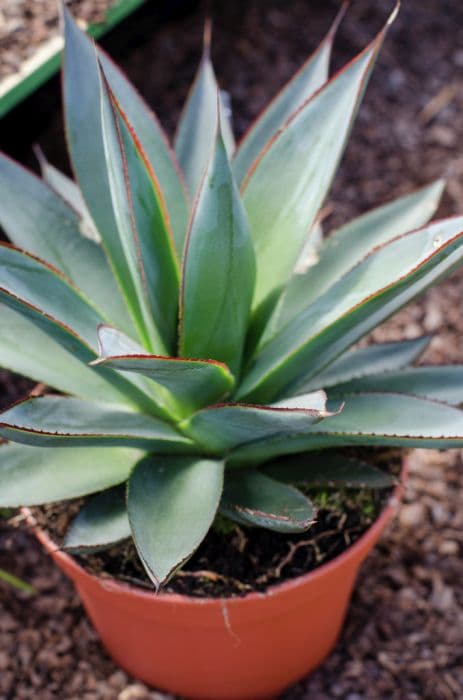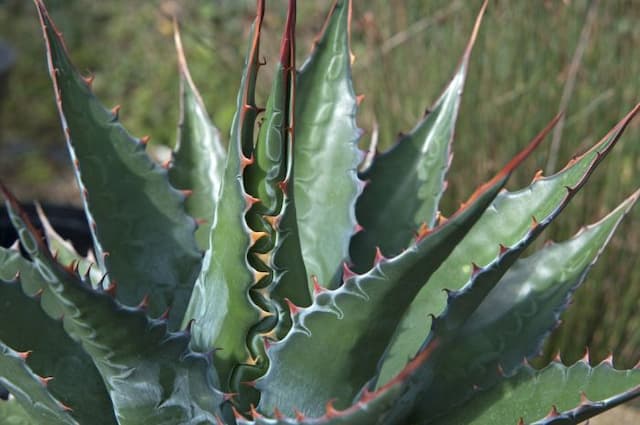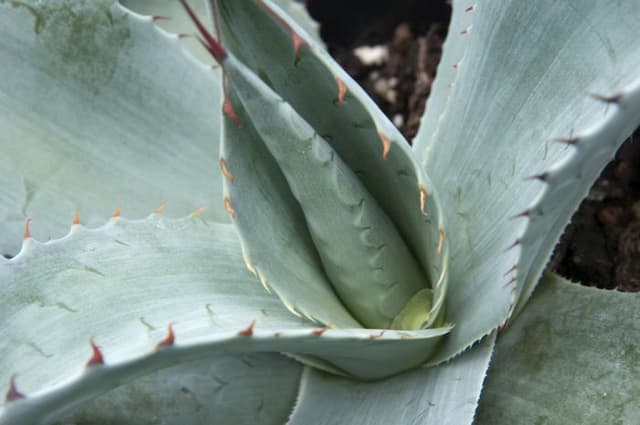Grape Hyacinth Muscari armeniacum 'Saffier'

ABOUT
Muscari armeniacum 'Saffier', commonly known as Grape Hyacinth 'Saffier', is a bulbous perennial known for its captivating spring blooms. The plant produces dense spikes of deep blue flowers that resemble an upside-down cluster of grapes, which is where the name Grape Hyacinth originates. Each individual flower is bell-shaped, with a slight opening at the bottom. The petal edges are sometimes highlighted with a contrasting white rim, adding a delicate touch to the appearance. The sturdy flower spikes emerge from a base of linear, green, and strap-shaped leaves that are glossy and can sometimes have a fleshy texture. They form a lush, green backdrop that accentuates the deep blue hue of the blooms. The flowers not only add visual appeal but also emit a light, sweet fragrance that is very appealing during their blooming season.
About this plant
 Names
NamesFamily
Asparagaceae.
Synonyms
Grape Hyacinth, Armenian Grape Hyacinth, Garden Grape-hyacinth.
Common names
Muscari armeniacum 'Saffier'.
 Toxicity
ToxicityTo humans
Grape hyacinth is considered to have a low level of toxicity to humans. If ingested, it may cause minor symptoms such as nausea, vomiting, and diarrhea. It is important to teach children not to eat any part of ornamental plants due to potential risks.
To pets
Grape hyacinth may also be toxic to pets if ingested. While it is generally considered to have a low level of toxicity, consumption can result in gastrointestinal upset, such as vomiting and diarrhea in cats and dogs. Pet owners should prevent their pets from consuming this plant to avoid these possible symptoms.
 Characteristics
CharacteristicsLife cycle
Perennials
Foliage type
Deciduous
Color of leaves
Green
Flower color
Blue
Height
6 inches (15 cm)
Spread
3 inches (7.5 cm)
Plant type
Bulb
Hardiness zones
4
Native area
Western Asia
Benefits
 General Benefits
General Benefits- Easy to Grow: Muscari armeniacum 'Saffier', also known as grape hyacinth, is a robust and low-maintenance plant, making it ideal for gardeners of all levels.
- Attracts Pollinators: Grape hyacinths produce nectar-rich flowers that attract bees and butterflies, supporting local ecosystems.
- Adds Color: The plant blooms with vibrant blue-purple flowers in the spring, providing a beautiful color display in gardens and landscapes.
- Naturalizes Easily: Grape hyacinths can multiply and spread over time, creating a natural, effortless ground cover in appropriate climates.
- Compact Size: The small stature of grape hyacinths makes them suitable for planting in rock gardens, borders, and containers.
- Deer and Rodent Resistant: The plant is generally resistant to deer and rodents, keeping your garden intact without the need for additional deterrents.
- Drought Tolerant: Once established, grape hyacinths can tolerate periods of dryness, making them suitable for xeriscaping and water-wise gardens.
- Long Blooming Period: The bloom time of grape hyacinths extends over several weeks, providing long-lasting visual interest.
- Combines Well with Other Plants: Grape hyacinths pair well with other spring bulbs and perennials, allowing for creative gardening designs.
- Cut Flower Use: Grape hyacinths can be used as fresh cut flowers for indoor arrangements, bringing springtime beauty indoors.
 Medical Properties
Medical PropertiesThis plant is not used for medical purposes.
 Air-purifying Qualities
Air-purifying QualitiesThis plant is not specifically known for air purifying qualities.
 Other Uses
Other Uses- Container Gardening: Muscari, also known as Grape Hyacinth, can be grown in pots or containers, making it suitable for balconies and patios where ground space is limited.
- Dye Production: The bulbs of Grape Hyacinth can be used to produce a yellow-green dye for coloring wool and other fabrics.
- Rock Gardens: Grape Hyacinth is a good addition to rock gardens due to its small size and ability to grow in well-drained soil and withstand dry conditions once established.
- Educational Projects: Due to their easy care and quick blooming, these plants are often used in educational settings to teach children about plant growth and gardening.
- Guided Walkways: Planting Grape Hyacinth along pathways creates a delightful, colorful border that guides visitors through gardens or landscapes.
- Pressed Flower Art: The flowers of Grape Hyacinth can be pressed and used to create botanical art pieces or in paper making for a decorative touch.
- Eco-Friendly Confetti: Dried flowers of Grape Hyacinth can be used as biodegradable confetti for outdoor celebrations, reducing the environmental impact.
- Fragrance Sachets: The blooms of Grape Hyacinth, when dried, can be added to sachets to provide a natural, light fragrance to drawers and closets.
- Living Mulch: When planted in dense patches, Grape Hyacinth can act as a living mulch, suppressing weeds and hydrating the soil with its shade.
- Fairy Gardens: The small and whimsical appearance of Grape Hyacinth makes it fitting for use in miniature fairy garden designs, adding a touch of charm and fantasy.
Interesting Facts
 Feng Shui
Feng ShuiThe Grape Hyacinth is not used in Feng Shui practice.
 Zodiac Sign Compitability
Zodiac Sign CompitabilityThe Grape Hyacinth is not used in astrology practice.
 Plant Symbolism
Plant Symbolism- Perseverance: Commonly known as grape hyacinth, Muscari armeniacum 'Saffier' blooms early in the spring, demonstrating resilience and the ability to thrive in challenging conditions, symbolizing steadfastness and determination.
- Trust: The sturdy and reliable growth of the grape hyacinth, returning year after year, can represent trust and dependability in relationships and personal commitments.
- Beauty: With their striking blue hues, grape hyacinths are often interpreted as symbols of natural beauty and elegance, suggesting an appreciation for the aesthetic pleasures in life.
- Power: The vibrant, dense clusters of blooms exhibit a visual strength that can symbolize power, particularly the quiet power inherent in nature's persistent growth.
 Water
WaterGrape Hyacinth should be watered when the top inch of soil feels dry to the touch, which could be roughly once a week during active growth in the spring. It's hard to specify an exact amount since it will vary based on climate and soil drainage, but one to two gallons per week is a good starting point. Outdoor plantings may require less frequent watering if rainfall contributes to soil moisture. Overwatering can lead to bulb rot, so it's crucial to ensure proper drainage. Water should be applied directly to the soil and not over the foliage to prevent mold and fungal diseases.
 Light
LightGrape Hyacinth thrives in full sun to partial shade conditions. The plant does best with morning sunlight and afternoon shade, especially in hotter climates to prevent scorching. An ideal spot would be a location that receives at least six hours of sunlight each day. These lighting conditions will encourage the most vigorous bloom.
 Temperature
TemperatureGrape Hyacinth prefers cool to moderate temperatures, with an ideal range being between 50°F and 75°F. They can survive brief periods of colder weather down to about 20°F and are winter hardy in zones 4 through 8. During active growth and blooming in the spring, maintaining a consistent temperature within this range will promote the healthiest growth.
 Pruning
PruningPruning Grape Hyacinth generally means deadheading the spent flowers after blooming is complete to keep the plant looking tidy and prevent self-seeding. The foliage should not be cut back until it has died down naturally, as the leaves are needed to store energy in the bulbs for the following year's growth. Pruning is typically done annually, immediately after flowering.
 Cleaning
CleaningNot needed
 Soil
SoilGrape Hyacinth 'Saffier' thrives in well-draining soil with a mix of loam and sand to ensure proper drainage. A pH level of 6.0 to 7.0 is ideal for these bulbs, so slightly acidic to neutral soil conditions are best. A blend of two parts garden soil, one part sand or perlite, and one part compost or peat is a good starting mix for these plants.
 Repotting
RepottingGrape Hyacinth 'Saffier' generally does not require frequent repotting. These bulbs can be left undisturbed for several years as they prefer to be slightly pot-bound. Repotting every 3-5 years in autumn should suffice, or when the clumps become overcrowded.
 Humidity & Misting
Humidity & MistingGrape Hyacinth 'Saffier' is quite adaptable and does not require high humidity levels. Average room humidity is generally sufficient for these plants, though they can tolerate a range from dry to moderately humid conditions without any special requirements.
 Suitable locations
Suitable locationsIndoor
Place Grape Hyacinth 'Saffier' near bright windows, water when dry.
Outdoor
Plant Grape Hyacinth 'Saffier' in well-drained soil, full or partial sun.
Hardiness zone
4-8 USDA
 Life cycle
Life cycleThe life cycle of Muscari armeniacum 'Saffier', commonly known as Grape Hyacinth 'Saffier', begins with seed germination, which occurs in autumn when temperatures drop and moisture levels increase. The seeds develop into bulbs, which overwinter underground and enter a period of dormancy until spring. In early to mid-spring, the bulbs send up narrow, strap-like green leaves and erect flower stalks, which bear dense clusters of small, urn-shaped blue flowers. Following pollination, typically by bees attracted by the flowers' sweet fragrance, the plant sets seed while the foliage starts to die back as the plant enters summer dormancy. The seeds disperse into the surrounding soil to complete the cycle or the bulbs may also multiply by producing offsets. In subsequent years, these bulbs or offsets will grow, mature, and repeat the cycle, leading to an increase in the plant's population in its growing area.
 Propogation
PropogationPropogation time
Early autumn
Propogation: The most popular method of propagation for Grape Hyacinth, specifically the Muscari armeniacum 'Saffier', is through division of its offsets or bulbs. This usually takes place in the fall after the leaves have died back. Gardeners can gently dig up the bulbs and separate the smaller offset bulbs from the mother bulb. These offsets can then be replanted immediately at a depth of about 3 to 4 inches (approximately 7.5 to 10 centimeters), spaced a few inches apart. They should be planted in well-drained soil with some exposure to sunlight. With proper care, these offsets will develop into mature, flowering plants over the course of one to two growing seasons.









